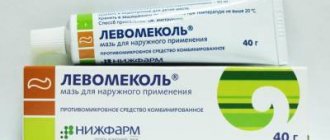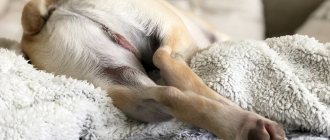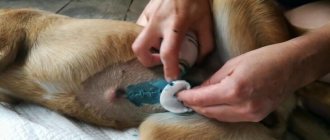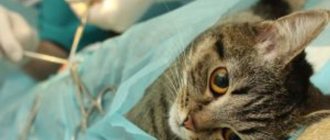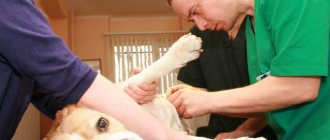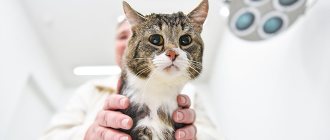Types of sterilization
Ovariectomy is a simple veterinary procedure to remove the ovaries (sometimes along with the uterus) in female dogs. It is possible to carry out the procedure with minimal surgical intervention, which increases its cost. There are only 5 types of pregnancy prevention.
| Name | Technology |
| Classical | Removal of the ovaries and uterus by making an incision along the sides of the abdominal cavity or along the linea alba. |
| Partial | It is carried out in the same way as the classic one, but the uterus is left behind. The procedure is recommended for young people. |
| Tubal occlusion | An operation with questionable effectiveness is based on tubal ligation to prevent sperm from entering the uterus. |
| Endoscopic | The insertion of a manipulator and an endoscope into the abdomen, the procedure is monitored on a computer monitor, this allows you to avoid cutting the abdomen. |
| Chemical | Introduction of injections that block sexual heat and estrus, reducing reproductive function. The method requires regular repetition, it affects the liver and the general health of the body. |
Postoperative suture: processing basics and precautions
The dog's suture after sterilization deserves special attention from the owner , since this place is most susceptible to infection, hurts and brings considerable discomfort to the animal. To prevent the development of inflammatory postoperative complications in the wound, veterinarians tend to prescribe antibacterial drugs to dogs, which should be given to the pet for 7-10 days after surgery. Along with antibiotics, the animal is advised to take drugs with an analgesic effect, the selection and dosage of which should be handled by a specialist, taking into account the severity of the pain syndrome and the characteristics of the dog’s body.
Correct treatment of the seam is an important step on the dog’s path to recovery. Its volumes and methods of implementation depend on the characteristics of the suture material that was used during the operation. In most cases, the postoperative suture requires daily treatment with antiseptics until the wound is completely healed and swelling and redness disappear. An additional means of protecting the seam is a special blanket, which is put on the dog at the end of the operation. It serves both as a reliable protection against bacteria and as a bandage. The blanket also needs to be changed every day to prevent infection in the wound. Dogs that show increased interest in their stitches, try to remove the blanket or bite the stitches, are put on an Elizabethan collar.
In order for a dog’s suture to heal normally after sterilization and not rip apart prematurely, the following conditions must be met:
- limit your pet from active games on the street and at home, physical activity, and walking in the stairwell;
- in rainy weather, walk the dog exclusively in overalls;
- refuse to bathe the animal in the first three weeks after sterilization;
- prevent constipation.
Before the sutures are removed, 10 to 14 days should pass after the operation. This is the time necessary for complete healing of the wound and sufficient regeneration of skin tissue at the site of the incision. The removal of sutures should be carried out by a veterinarian in a specialized office, so you should not try to get rid of them yourself, as such actions can cause irreparable harm to the health of the animal.
To sterilize or not
Each owner decides for himself whether to sterilize the female or not. The procedure does not cause any reasonable harm to health, but does provide benefits. Of course, purebred bitches intended for breeding are not operated on without serious reasons (genital or reproductive diseases).
Such girls are bred only through a nursery to obtain official offspring with documents and pedigree. Specialists select a high-quality male dog. The owner takes full responsibility for the maintenance and resale of the babies.
Representatives of the pet class (animals with slight deviations from the standard) are rarely bred “for health”, after which they are sterilized, because this helps correct behavior and prevents infectious and sexually transmitted diseases. The advantages of the operation include:
- balancing the psyche, suppressing aggression during sexual heat, qualitatively improving working skills, simplifying the training process (the dog is calm, focused, obedient);
- absence of odor and discharge from the loop (which protects the owners and the female from attracted males);
- often, the pet’s life is extended by 2-3 years;
- due to the lack of sexual instinct, the bitch does not mark her territory during estrus;
- this is the simplest and most convenient way to avoid unplanned pregnancy and unnecessary offspring (especially for yard dogs);
- the procedure prevents infection with sexually transmitted infections, reduces the risk of developing pyometra (inflammation of the cervix), cysts, ovarian tumors, and false pregnancy.
The disadvantages of oophorectomy, to a greater extent, manifest themselves with an unskilled approach to work, the use of non-sterile materials, and operation without the necessary knowledge. A doctor with insufficient experience cannot guarantee the complete safety of the procedure. As a result, soft tissues become inflamed, sutures rupture, and bleeding occurs.
The veterinarian will help you choose the right anesthesia and painkiller; in rare cases, the drugs have a negative effect on the pet’s body.
Due to changes in hormonal levels, a sterilized animal quickly gains weight; this can be avoided by using special food. Due to urinary incontinence, kidney and urinary tract diseases develop (stones and sand are formed).
Pros of sterilization
There are many advantages to sterilization and, first of all, it has a positive effect on the physical and psychological health of dogs:
- the likelihood of cancer occurring in both females and males is reduced;
- the life expectancy of the animal increases;
- do not become infected with sexually transmitted infections;
- the animal becomes less aggressive and more balanced and flexible. It has been noticed that those who are sterilized before a year are easier to train;
- males do not react to bitches in heat - they do not run away from home, do not participate in fights with other males, finding out who is more important and stronger;
- males are less aggressive towards others and hardly mark their territory;
- Bitches do not have false pregnancy.
For owners who do not participate in exhibitions with their pets, do not plan to engage in breeding, or have a mongrel dog, especially if it is a girl, sterilization is a solution to many problems. Animals will not run away from the house at the time of sexual activity, a pack that is attracted to dogs in heat will not gather near the entrance or gate, and unwanted mating will be excluded. It is better to sterilize a dog than to throw puppies out into the street, and this often happens to those babies who could not be sold or placed in “good hands.”
Age
There is no clear belief among veterinarians at what age to perform surgery. There are no special indications that limit the owner’s time, but there are risk factors associated with too early or late sterilization:
- Elderly or aging dogs are more difficult to tolerate anesthesia, pain shock, and stress; take longer to recover;
- When carrying out the procedure up to 6-7 months, a developmental delay in the female, late maturation, and regeneration of the reproductive organs are guaranteed.
Despite possible negative consequences, adult bitches (after 8 years), regardless of whether they have given birth or not, are spayed to avoid the growth of cancerous tumors. The last birth should take place no later than 6 years.
Pregnancy and childbirth
Terminating a pregnancy or birth process in female dogs is a dangerous operation during which the animal loses a lot of blood. Experts recommend that dogs give birth and feed conceived babies, and in case of unwanted fertilization, interrupt the course in the early stages with medication.
During pregnancy
There is an unspoken rule in veterinary medicine - a ban on sterilization of pregnant females. No doctor can guarantee the success of the procedure and the absence of consequences. The optimal time for oophorectomy is 2-3 months after birth.
The exception is a medical prescription. If it is known that the female does not carry babies to term or will not be able to give birth, an emergency abortive procedure is performed followed by sterilization. It is better to operate early, while the uterus is not too enlarged and filled with fluid.
Puppies feel pain from birth, so if there are no options for placing babies, abortion is the most humane way to get rid of an unwanted pregnancy.
After childbirth
If the pet is a breeder and produces registered offspring, the optimal solution would be sterilization after 6 years, but not later than 8. A girl can give birth several times or bring offspring once - it does not matter.
If the dog is pregnant, and there are no plans to breed her after giving birth, then the operation can be performed at any age, but not earlier than a month after the end of feeding the babies.
Diet before surgery
Let’s be clear right away: we will talk about complete sterilization, i.e. about its abdominal or laparoscopic varieties.
No special preparation is required before chemical infertility, but surgery is a completely different matter. In particular, proper diet plays a huge role:
- The dog should not be fed approximately eight hours (but preferably 12 hours) before the scheduled date of surgery.
- Another four (but preferably six) hours before surgery, the pet is not allowed to drink.
To some, such rules may seem unnecessarily cruel, but it is better to follow them. During anesthesia, the innervation of all internal organs, including the gastrointestinal tract, changes significantly. If your pet has a full stomach during surgery, she will almost certainly vomit. And all the vomit will go straight to the lungs. The result is aspiration pneumonia, which in almost 70% of cases ends in the death of the pet.
Estrus
Puppies mature by 8-10 months, at which time the first heat begins (depending on the breed and genetic predispositions; small dogs come into heat earlier). Large breeds are characterized by late maturation and maturation; it is more difficult to determine the optimal period for them, so the opinions of experts are divided.
Is it possible to spay a dog before her first heat?
Some recommend surgery 1-2 months before the start of the cycle change. But it is almost impossible for the owner to calculate this period on his own. Therefore, the best option is oophorectomy 2 months after the onset of estrus.
You can consult with the breeder, find out how the mother, grandmother, and sisters of the pet matured. This will help determine the approximate time appropriate for surgery. At the veterinary clinic they take tests for the presence of hormones, after which a specialist will give recommendations for sterilization
During heat
Theoretically, estrus does not affect the progress of the operation, but veterinarians recommend waiting 2-3 weeks after its completion. The fact is that during the change of cycles, the girl’s body weakens, the cervix opens, which gives the green light to all viruses. Surgery in this condition risks introducing infection into the internal organs.
The owner himself decides when to sterilize his dog, and whether it is necessary. Veterinarians do not have the right to decide for the owner, but it is better to listen to the recommendations in order to avoid serious complications and mental imbalances.
How much does it cost to sterilize a dog?
The price and nature of the manipulations will depend on the weight and health status of the animal revealed during the examination. When you estimate future financial costs, you need to consider the cost of post-operative care for the animal. You can find out how much it costs to sterilize a dog in our clinic on the clinic’s website or by phone. You will be advised and told in detail about how much it costs to sterilize a dog, and what manipulations will be included in this price.
Cost of sterilization of pets in Moscow
| Vet clinic | Metro | Castration | Sterilization | Hospital |
| CAT+BEHEMOTH on Krasnobogatyrskaya | Preobrazhenskaya Square | from 2125 to 2500 rub. | from 3825 to 4500 rub. | – |
| BRANCH | Maryino | up to 1500 rub. | from 3500 to 5000 rub. | – |
| CONSTELLATION at VDNH | VDNH | from 1800 to 2000 rub. | from 5000 to 5500 rub. | from 600 to 1750 rub. |
| 10 LIVES on Molodezhnaya | University | from 1200 rub. | from 2650 rub. | 600 rub. |
| ARS MEDICA on Bibirevskaya | Bibirevo | from 1600 rub. | from 3000 rub. | no data |
| ACHILLES on Belozerskaya | Bibirevo | from 2100 rub. | from 4900 rub. | – |
| ACHILLES on Dubninskaya | Altufyevo | from 2100 rub. | from 4900 rub. | no data |
| SPECTRUM-VET on Izumrudnaya | Babushkinskaya | from 1900 rub. | from 3750 rub. | from 500 to 950 rub. |
| AIBOLIT on Zavodskaya | Volokolamsk | from 2000 rub. | 4500 rub. | up to 800 rub. |
| AMIGO on Kedrova | Academic | from 2500 rub. | from 5000 rub. | from 1200 rub. |
| GORVETMED on Rublevsky | Youth | from 1500 rub. | from 3500 rub. | – |
| KOLIBRI in Lobnya | – | from 1500 rub. | from 3800 rub. | from 600 rub. |
| DARWIN on Kantemirovskaya | Kantemirovskaya | from 1200 rub. | from 3200 rub. | from 600 rub. |
| FAUNA on Sirenevoe | Shchelkovskaya | from 1800 rub. | from 2500 rub. | up to 1500 rub. |
| ZOOMEDIC on Dmitry Ulyanov | Academic | from 3000 rub. | from 4000 rub. | from 600 rub. |
| TIM on Lavochkina | River Station | from 1550 to 4000 rub. | from 3900 to 7000 rub. | 800 rub. |
| GREEN PARROT on the highway Enthusiasts | – | from 3000 to 8000 rub. | from 5000 to 15000 rub. | from 500 to 1500 rub. |
| INNOVET on General Kuznetsov 12 | Zhulebino | from 1500 to 3500 rub. | from 4500 rub. | from 500 to 3000 rub. |
| VESTA on Buzheninova | Elektrozavodskaya | from 2000 rub. | from 4000 rub. | from 450 rub. |
| BELADONNA on the street. Ryabinova 69 building 1 | Slavyansky Boulevard | from 2500 rub. | from 7700 rub. | from 2000 rub. |
Sterilization of dogs in St. Petersburg
| Vet clinic | Area | Castration | Sterilization | Hospital |
| YOUR DOCTOR in Vitebsk | Moscow | from 1100 rub. | from 2600 rub. | no data |
| STRELNA | Petrodvortsovy | from 1200 rub. | from 2800 rub. | – |
| BLUE CROSS on Opochinina | Vasileostrovsky | from 1500 to 12000 rub. | up to 12,000 rub. | – |
| BAMBI on Sedova | Nevsky | from 1000 to 6000 rub. | from 2800 to 7100 rub. | – |
| CITYVET on Ushinskogo | Kalininsky | 1600 rub. | from 3000 to 4400 rub. | 800 rub. |
| VASILEOSTROVSKY DISTRICT on the 17th Line | Vasileostrovsky | from 1500 rub. | from 2800 rub. | – |
| "HEALTHY ANIMALS" on Koroleva | Seaside | 1400 rub. | from 2500 rub. | – |
| VETERINARY HOSPITAL on Krzhizhanovsky | Nevsky | from 1200 to 2800 rub. | from 2200 to 2800 rub. | from 400 to 600 rub. |
| DYUSHA on Soldier Korzun | Kirovsky | from 1200 rub. | from 2700 rub. | – |
| MEDEA on the street Leni Golikova 27 | Kirovsky | from 1500 rub. | from 3000 rub. | 800 rub. |
| IRBIS on Enlightenment | Kalininsky | 1500 rub. | 2800 rub. | from 500 to 600 rub. |
| GOOD HANDS on Shlisselburgsky | Nevsky | from 1300 rub. | from 3000 rub. | – |
| ELVET in the Far East | Nevsky | from 1500 rub. | from 3000 rub. | from 1200 to 2400 rub. |
| VIRION on Novoizmailovsky | Moscow | up to 1500 rub. | from 2500 to 3100 rub. | from 800 rub. |
| THE DOCTOR IS NOT SICK on Enlightenment | Kalininsky | from 1500 rub. | from 4000 rub. | 400 rub. |
| DOCTOR BURLAKOV on Budapestskaya | Frunzensky | 1000 rub. | call | – |
| MURKA on Civil | Kalininsky | 1300 rub. | from 2600 to 3000 rub. | – |
| ALMAVET on Moskovskaya-Sortirovochnaya | Nevsky | from 1100 rub. | from 2600 rub. | from 350 rub. |
| VETERINARY CLINIC OF THE ZOO in Aleksandrovsky | Petrogradsky | from 1600 rub. | from 2700 rub. | – |
| KIROVSKY DISTRICT on Shvetsova | Admiralteysky | from 2500 to 3000 rub. | from 3500 to 4000 rub. | – |
Sterilization of dogs in Yekaterinburg
| Vet clinic | Area | Castration | Sterilization | Hospital |
| ZOODOKTOR on Aptekarskaya | Chkalovsky | from 1000 rub. | from 2000 rub. | from 600 rub. |
| ZOODOKTOR on Moskovskaya | Leninist | from 1000 rub. | from 2000 rub. | from 600 rub. |
| ZOODOKTOR on Cultures | Ordzhonikidzevsky | from 1000 rub. | from 2000 rub. | from 600 rub. |
| EARS, FEET, TAIL in the center of Yekaterinburg | Leninist | from 800 to 1000 rub. | from 3000 rub. | no data |
| VETA on Lunacharsky | Railway | from 1000 rub. | from 2500 rub. | no data |
| HACHIKO on Posadskaya | Verkh-Isetsky | from 750 rub. | from 1700 rub. | from 800 rub. |
Sterilization of dogs in Novosibirsk
| Vet clinic | Area | Castration | Sterilization | Hospital |
| VETLEKAR on Krasnoe | Zaeltsovsky | from 1500 rub. | from 2700 rub. | from 500 rub. |
| VETIKA on the Shamshin Family | Central | from 1500 rub. | from 3700 rub. | no data |
| VETERINARY CENTER on Vysotskogo | October | from 1500 rub. | call | no data |
| VETERINARY CENTER on Novosibirskaya | Leninist | from 1500 rub. | call | no data |
| FRIEND on Vybornaya | October | from 1500 rub. | from 4000 rub. | from 800 rub. |
| BEST on Kaunasskaya | Zaeltsovsky | from 1500 rub. | from 3000 rub. | from 1000 rub. |
| VIAPRIM on Boris Bogatkov | Mosrentgen | from 1000 rub. | from 2800 rub. | from 800 rub. |
| DOCTOR VET in Akademgorodok | Soviet | from 1500 rub. | from 3000 rub. | from 1000 rub. |
| VETERINARY CENTER in Gorskoe | Leninist | from 1500 rub. | call | no data |
| VETACLINIC on Serebrennikovskaya | Central | from 1500 rub. | from 4000 rub. | no data |
| ARTEMIS + on Red | Zaeltsovsky | from 1300 rub. | from 3000 rub. | from 1000 rub. |
| BEST on Pokryshkina | Kirovsky | from 1500 rub. | from 3000 rub. | from 1000 rub. |
| VET DOCTOR on Ordzhonikidze | Central | from 1000 rub. | from 2600 rub. | no data |
| DOCTOR VET on Kosmomolskaya | – | from 1000 rub. | from 2000 rub. | no data |
| BEST on Frunze | Central | from 1500 rub. | from 3000 rub. | from 1000 rub. |
Sterilization of dogs in Nizhny Novgorod
| Vet clinic | Area | Castration | Sterilization | Hospital |
| VET EMERGENCY on the street. Hero Yuri Smirnov | Avtozavodsky | from 1200 rub. | from 2200 rub. | no data |
| VET EMERGENCY on the street. Cultures | Sormovsky | from 1200 rub. | from 2200 rub. | no data |
| VET EMERGENCY at sh. Moskovskoe | Kanavinsky | from 1200 rub. | from 2200 rub. | from 400 rub. |
| PUSSY STAR on Old Producers | Avtozavodsky | from 800 rub. | from 1500 rub. | no data |
| VETCENTER on Volzhskaya | Kanavinsky | from 800 rub. | from 1700 rub. | no data |
| LORD on Perekopskaya | Leninist | call | call | no data |
| LEO on Klimovskaya | Kanavinsky | from 700 rub. | from 1500 rub. | from 250 rub. |
| NIZHNY NOVGOROD VETERINARY HOSPITAL on Nartova | Soviet | from 1000 rub. | from 1900 rub. | from 300 rub. |
| RED CAT on Berezovskaya | Moscow | from 900 rub. | from 3000 rub. | no data |
| PUSSY STAR on Nartova | Soviet | from 800 rub. | from 1500 rub. | no data |
| FAUNA on Gagarin | Prioksky | call | call | no data |
| VET EMERGENCY on the street. Proletarskaya | Kanavinsky | from 1200 rub. | from 2200 rub. | no data |
| 101 DALMATINES on Gagarin | Soviet | call | call | no data |
| VET EMERGENCY on Ave. Lenin | Leninist | from 1200 rub. | from 2200 rub. | no data |
| VET EMERGENCY on the street. Admiral Vasyunin | Soviet | from 1200 rub. | from 2200 rub. | no data |
| FAUNA on Semashko | Nizhny Novgorod | call | call | no data |
| PERSPECTIVE on German Lopatin | Nizhny Novgorod | from 1200 rub. | from 2300 rub. | no data |
Sterilization of dogs in Kazan
| Vet clinic | Area | Castration | Sterilization | Hospital |
| DOCTOR VASIN N.N. on the street Richard Sorge | Privolzhsky | 1500 rub. | from 2000 to 3500 rub. | – |
| OBEREG on Gvardeiskaya | Soviet | from 1000 rub. | from 1800 rub. | from 100 rub. |
| 911 on Kulakhmetova | Moscow | from 1200 rub. | from 2000 rub. | no data |
| GOOD DOCTOR on the street. Professor Kamaya 15a | Privolzhsky | from 1300 rub. | from 2300 rub. | no data |
| 911 on Chistopolskaya | Moscow | from 1200 rub. | from 2000 rub. | no data |
| 911 on Korolenko | Novo-Savinovsky | from 1200 rub. | from 2000 rub. | no data |
| 911 to Ibragimov | Moscow | from 1200 rub. | from 2000 rub. | no data |
Video
Preparing for sterilization
To be confident in the effectiveness and accuracy of oophorectomy, it is better to select a clinic in advance, discuss all issues with a veterinarian, invite a specialist to your home, if necessary, and discuss the date and final cost.
On average, the operation costs 4,000-10,000 rubles, depending on the anesthesia drugs used and the method of sterilization.
The animal must be healthy - this is the most important criterion for surgery. Monitor your well-being for 3 days, measure your temperature in the morning and evening. Indicators should be normal: 37.5-39°C. A strong, healthy dog has a good appetite, a playful mood, a wet, cold nose, and no signs of poisoning (diarrhea, vomiting).
Mandatory deworming is carried out two weeks in advance. They are cleared of worms with medication, suspensions or tablets are administered (Milbemax, Prazitex, Drontal Plus). It is also recommended to get rid of ectoparasites (fleas, ticks), which cause postoperative complications.
The pet must be vaccinated according to age, the vaccination period should not be later than 1 year. An unvaccinated animal poses a threat to the veterinarian. And the risk of getting serious infectious diseases without the necessary injections increases.
To avoid nausea and vomiting under anesthesia, pets are not fed 10-12 hours before the procedure. In the evening the animal is deprived of food, and in the morning its drink is taken away.
Negative aspects of sterilization
Sterilizing dogs has both pros and cons, but they are few. In addition, all problems that arise during or after the operation can be solved.
One of the problems is a complication after surgery, which most often occurs with unscrupulous veterinarians:
- inflammatory process or infection that occurs when hygiene standards and sterility of instruments are not observed;
- bleeding, which may be due to improper manipulation by an inexperienced veterinarian;
- intolerance to anesthesia, but the responsible doctor must find out this before the operation begins.
Sterilization of a dog should be carried out in a trusted veterinary clinic, where the doctor will foresee possible risks, first take blood for analysis and be sure to check the animal’s heart function. You should not have surgery with a dubious specialist.
The consequences of sterilizing a dog can manifest itself in metabolic disorders. At the same time, the pet’s appetite increases and there is a constant feeling of hunger. Nutrients are not properly absorbed, which leads to obesity. This problem can be solved by balancing the dog’s diet, increasing physical activity and walking time.
In some cases, after sterilization, there may be a side effect such as urinary incontinence or other pathologies of the urinary system. Additional treatment will be required, which will be effective if started on time.
Post-operative care
The dog is left under the supervision of doctors for the whole day. If the operation is scheduled for the morning, then you can pick up your pet only in the evening. Immediately after, the girl is placed on an absorbent diaper and covered with a blanket (the body temperature drops, the animal gets very cold). Every 20-30 minutes, moisten your nose and tongue with water.
The patient is fed and watered every other day. They prefer soft, liquid foods (broths, kefir, ground meat, purees). In the first two days the girl will be lethargic and without appetite. This reaction is considered normal. Until the anesthesia completely recovers, the paws may go numb. The main thing is not to allow physical activity to occur.
The seam on the stomach requires protection. Therefore, the female is dressed in a special blanket; for better protection from licking, an Elizabethan collar is used. Change clothes once a day, they get dirty quickly. The veterinarian prescribes anti-inflammatory antiseptics; the incision needs to be lubricated for at least a week, 7-14 days until the stitches heal and are removed. To relieve the pain symptom, painkillers (injections or tablets) are administered.
Special attention is paid to sterilized pets not only in the postoperative period, but throughout their lives. Girls will need a special low-carbohydrate diet, a balanced diet, and moderate but sufficient physical activity to stay in shape. Special foods for neutered dogs are ideal.
Sterilization procedure
Before the operation begins, the doctor administers anesthesia. It can be of several types:
- Inhalation , when a special gas mixture is supplied. This technology is considered the most advanced, but is not yet available in all clinics.
- Intravenous , involves the administration of drugs for anesthesia, analgesia and muscle relaxation.
- Intramuscular . A combination of different drugs is used. Used everywhere.
- Epidural anesthesia . Involves the introduction of anesthetics into the spinal canal.
After administering anesthesia, the surgeon removes the hair to make the incision easier. After cutting, he performs work to remove organs and applies sutures.
In general, the entire procedure, including preparation and administration of anesthesia, takes no more than an hour.
Caring for your dog after surgery
Since the functioning of all organs slows down under the influence of anesthesia, the animal may freeze. Cover it with a blanket and place it on a flat surface, not near drafts or radiators.
Place absorbent diapers under your dog and change them as needed.
Every half hour, turn your pet from one side to the other to avoid numbness of the limbs and swelling of the lungs.
Until your pet wakes up, monitor your breathing and heartbeat. Apply Artificial Tears drops every 30 minutes to moisturize the mucous membranes of the eyes.
After waking up, the animal will stagger and fall, so the owner’s task is to prevent it from getting injured.
If your pet does not allow you to approach her, leave her and watch from the side.
In each specific situation, the veterinarian will prescribe a specific drug for treating sutures.
If the wound takes a long time to heal, inflammation and pus are observed, a second consultation is necessary. If your pet tries to chew the seam, use a blanket.
During the period of recovery from anesthesia, you should not rush into feeding - this can provoke vomiting.
In the first three days, the dog can starve without harm to its health, and if it holds its head well, you can give it water.
Then you can switch to light food - soups, purees, dry food soaked in water. And after a week, return your pet to its usual diet.
On average, it takes no more than two weeks for the animal to fully recover.
Complications after sterilization
Complications after surgery are rare, but sometimes they do occur. These include:
- suture divergence – occurs primarily due to non-compliance with postoperative care rules,
- disturbances in the functioning of the heart - can be provoked by the administration of anesthesia,
- internal bleeding, as well as infections and inflammations - occurs due to the negligence of the surgeon,
- urinary incontinence - can be successfully treated if measures are taken in time,
- Metabolic disorder – appetite increases, the animal begins to gain weight.
Changes in dog behavior after sterilization
The dog retains its inherent character traits. Mobile active individuals continue to play and run, aggression towards other animals and people disappears.
If the pet has become apathetic and lazy, the owner’s task is to interest him in fun, active games.
Sterilization, contrary to myths, does not lead to excess weight gain if you feed the animal in a balanced and correct manner.
Why you should spay your dog at home
Sterilization is considered a simple operation, so it is often performed at home. This gives a whole list of advantages:
- the animal remains at home, it is not subjected to stress by transportation to the veterinary center and back,
- the owner chooses a day convenient for himself, for example, on a weekend,
- doctors work around the clock,
- The quality of surgery performed at home is no worse than in a hospital.
The specialists of our veterinary center are ready to provide all the necessary assistance, from examination and preparation for surgery to postoperative care.
